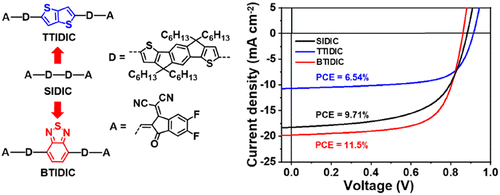当前位置:
X-MOL 学术
›
ACS Appl. Polym. Mater.
›
论文详情
Our official English website, www.x-mol.net, welcomes your
feedback! (Note: you will need to create a separate account there.)
Effects of π-Bridge on Fused-Ring Electron Acceptor Dimers
ACS Applied Polymer Materials ( IF 4.4 ) Pub Date : 2020-09-18 , DOI: 10.1021/acsapm.0c00748 Guilong Cai 1, 2, 3 , Yuhao Li 3 , Jiayu Wang 2 , Yiqun Zhang 3 , Xinhui Lu 3 , Jiarong Lian 1 , Pengju Zeng 1 , Yiping Wang 1 , Xiaowei Zhan 2
ACS Applied Polymer Materials ( IF 4.4 ) Pub Date : 2020-09-18 , DOI: 10.1021/acsapm.0c00748 Guilong Cai 1, 2, 3 , Yuhao Li 3 , Jiayu Wang 2 , Yiqun Zhang 3 , Xinhui Lu 3 , Jiarong Lian 1 , Pengju Zeng 1 , Yiping Wang 1 , Xiaowei Zhan 2
Affiliation

|
Two nonfullerene acceptors (TTIDIC and BTIDIC), consisting of indacenodithiophene (IDT) dimers bridged with electron-rich thienothiophene (TT) or electron-accepting benzothiadiazole (BT), were synthesized and compared with their counterpart SIDIC without a bridge to study effects of the bridge nature. Their thin-film absorption spectra and bandgaps are similar. The electron-rich TT bridge slightly up-shifts, whereas the electron-poor BT bridge slightly down-shifts energy levels of the dimers. Both TT and BT bridges enhance the electron mobilities of the dimers. When using polymer J71 as an electron donor, SIDIC-, TTIDIC-, and BTIDIC-based photovoltaic cells show efficiencies of 9.71, 6.54, and 11.5%, respectively. Compared to TT bridge, the BT bridge improves photovoltaic performance of the dimers.
中文翻译:

π桥对稠环电子受体二聚体的影响
合成了两个非富勒烯受体(TTIDIC和BTIDIC),它们由茚达二并噻吩(IDT)二聚体与富电子的噻吩并噻吩(TT)或电子接受的苯并噻二唑(BT)桥联而成,并与对应的SIDIC进行了比较,而没有研究桥联二噻吩的效应。桥自然。它们的薄膜吸收光谱和带隙相似。富电子的TT桥略微上移,而贫电子的BT桥略微下移二聚体的能级。TT桥和BT桥均增强了二聚体的电子迁移率。当使用聚合物J71作为电子供体时,基于SIDIC,TTIDIC和BTIDIC的光伏电池分别显示出9.71、6.54和11.5%的效率。与TT桥相比,BT桥提高了二聚体的光伏性能。
更新日期:2020-09-18
中文翻译:

π桥对稠环电子受体二聚体的影响
合成了两个非富勒烯受体(TTIDIC和BTIDIC),它们由茚达二并噻吩(IDT)二聚体与富电子的噻吩并噻吩(TT)或电子接受的苯并噻二唑(BT)桥联而成,并与对应的SIDIC进行了比较,而没有研究桥联二噻吩的效应。桥自然。它们的薄膜吸收光谱和带隙相似。富电子的TT桥略微上移,而贫电子的BT桥略微下移二聚体的能级。TT桥和BT桥均增强了二聚体的电子迁移率。当使用聚合物J71作为电子供体时,基于SIDIC,TTIDIC和BTIDIC的光伏电池分别显示出9.71、6.54和11.5%的效率。与TT桥相比,BT桥提高了二聚体的光伏性能。











































 京公网安备 11010802027423号
京公网安备 11010802027423号